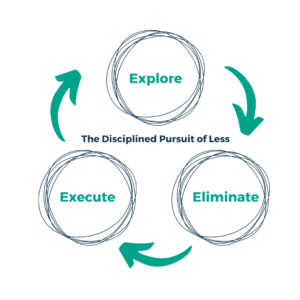There’s no doubt that life can be fast, noisy and has never been more digitally-driven. At times we can feel as if there is a constant stream of distractions and, coupled with the pressure to always do more, this can leave us feeling overwhelmed and dissatisfied.
Understanding the relationship we have with productivity, what it looks and feels like for us as individuals can be integral to implementing effective strategies to reclaim our attention, focus and support our wellbeing as a result.
So, what is the connection between productivity and wellbeing?
Research shows that a decrease in productivity or feeling unproductive can lead to dissatisfaction and a wider sense of unfulfillment. Perhaps you recognise a few of the following:
- The feeling of doing lot’s of tasks but never really finishing one completely
- Never feeling you have the time to finish a task in the way you would like
- Not feeling you have the time to do the things you really want and need, such as creative activities or seeing friends and family.
- Constantly worrying about things you feel you should or could be doing.
- Having time but not starting a task until the last minute and sitting thinking about it longer than you spend doing it, meaning you potentially run out of time.
Aspects such as this can create a cycle of productivity shame, which leads to a feeling of having never done enough and by virtue of that, not really resting.
In the workplace, hybrid and remote working in particular can exacerbate this issue, as our point of reference as to what ‘busy’ really looks like isn’t as easy to access, as well as the chance for peer support around tasks we get stuck on, which could further lead to procrastination.
Digital distractions can also further exacerbate, making it challenging for people to create the environment for focus around a subject and the ability to fully immerse in the work that needs to be done.
Recognising these challenges allows us to proactively address them and prioritise to support colleagues’ psychological, physical and emotional health, along with creating a productive environment for business.
Recognising the Signs of Lost Focus:
Aspects to watch out for include zoning out, distracting yourselves with tasks such as tidying cupboards, mindless eating, excessive social media scrolling, and avoiding tasks that require more thought in favour of tidying up your inbox or files. Any indicators that our minds have wandered or are looking for something that feels more ‘comfortable’ are all indicators that our minds have wandered, and we are no longer present. Recognising these behaviours and actions, means we can begin to take some simple steps to firstly understand what we might be feeling and secondly help us to move back towards what we need to do.
Break Productivity Shame Cycle:
Productivity shame is a growing phenomenon affecting many of us. The feeling of never having done enough, regardless of the number of tasks completed or hours worked, that leaves us feeling disappointed and even like a failure. As both an individual and as a people leader, it is crucial to understand that productivity shame is influenced by both individual and organisational factors, to create an environment that has self-compassion and support in the workplace for when we get stuck in the cycle.
The productivity shame cycle can significantly impact our wellbeing, including sleep problems, increased anxiety and a loss of perspective. Managing stress levels and exercising self-compassion is key to moving out of the cycle along with tactics such as setting intentions, creating conditions for flow state using models such as essentialism to self support, regain feelings of control and a sense of accomplishment.
Enabling ourselves to be more productive is important but equally as important is enabling ourselves to understand when we have been productive enough and take time out to recharge and relax to maintain our wellbeing.
Tactics To Take Back Control:
Maintain Your Five Wellbeing Fundamentals
As always, keeping the five backstops of wellbeing – sleep, nutrition, movement, connection and routine, in mind is key to supporting you in creating a mindset and energy to be in a place of productivity. Sleep quality and quantity in particular is key to managing energy and giving your body and mind the reset it needs to perform tasks and activities to the best ability. For more information on the five backstops, click here.
Setting Clear Intentions For Success
Being concrete with what you want to achieve, rather than vague, will help you gain clarity and momentum towards what you want to achieve. The aspects required for setting intentions effectively include:
When we are clearer in our intentions we reduce the feelings of overwhelm around a task, gain a feeling of accomplishment when the task is more manageable and gain the ability to be accountable.
Concrete actions bring a task into the present and adds a sense of urgency; which is great to help negate that pesky procrastination. Making a little bit of progress on a goal is enough to feed our motivation loop that can easily get stuck and help us begin to feel more positive.
Most importantly for wellbeing, when we clearly delineate actions it also gives us the agency to stop –to know when we’ve done enough, feel satisfied and take time out to recharge our minds in a different way.
Getting Into The Zone…and Finding Flow:
Flow is a state where action and consciousness merge together seamlessly and our task, activities and actions feel effortless.
When we find ourselves in flow, we can direct all of our attention towards a task or activity, so much so that for some we get a subjective feeling of time being altered.
When was the last time you were able to be fully immersed in a task, feeling energised but focused and enjoying the process rather than it feeling like a task?
Even though flow state can sound a bit intangible we must create the conditions for it as individuals but also when we think about how we support our teams in the workplace.
Here’s what we need to consider to create the environment for us to access flow:
- The activity must have clear goals and progress – direction and structure when performing the task.
- There must be clear and immediate feedback – to navigate changing demands so you can adjust your performance and maintain the state of flow.
- You must have a good balance between perceived challenges of the task and your own perceived skills. – you should have confidence that you are capable of completing the task.
If you’re a people leader and thinking about some simple aspects to sense check that can help support and enable your teams to access flow, then consider Owen Schaffer’s simpler seven conditions:
- Knowing what to do
- Knowing how to do it
- Knowing how well you are doing
- Knowing where to go (if navigation is involved)
- High perceived challenges
- High perceived skills
- Freedom from distractions
Becoming An Essentialist:
Essentialism is a way of ‘doing (rather than doing). This means doing less, but better, so you can make the highest possible contribution!
Essentialism isn’t about:
- Getting more done in less time.
- Getting less done.
It is about:
The right thing | In the right way | At the right time.
In particular, Essentialism helps us challenge a core assumption that has developed in this fast-paced world around ‘we can have it all’ and ‘I have to do everything’
This helps us to regain a feeling of control, our choices and where to spend our time and energy to best effect, for us – rather than giving it away to other people.
Identifying the VITAL FEW from the TRIVIAL MANY
| NON ESSENTIALIST | ESSENTIALIST | |
| All Things To All People | Less But Better | |
| THINKS: |
|
|
| Undisciplined Pursuit Of More | Disciplined Pursuit Of Less | |
| DOES: |
|
|
| A Life That Does Not Satisfy | A Life That Really Matters | |
| GETS: |
|
|
By applying a more selective criteria for what is essential, the pursuit of less allows us to regain control of our own choices so we can channel our time, energy and effort into making the highest possible contribution toward the goals and activities that matter.

Essentialism isn’t one more thing; it is a different way of doing everything. It is a discipline you apply constantly, and effortlessly. Essentialism is a mindset; a way of life.
Conclusion
Productivity and wellbeing are intertwined, and it is essential to prioritise both in our lives. By recognising the signs of lost focus, understanding productivity shame, and implementing effective strategies, we can unlock our productivity potential and enhance our overall wellbeing. Finding flow, being present in the moment, and taking concrete steps towards our goals will not only lead to increased productivity but also a greater sense of fulfilment. Let us break free from the distractions that hinder us and embrace a balanced and productive life.










